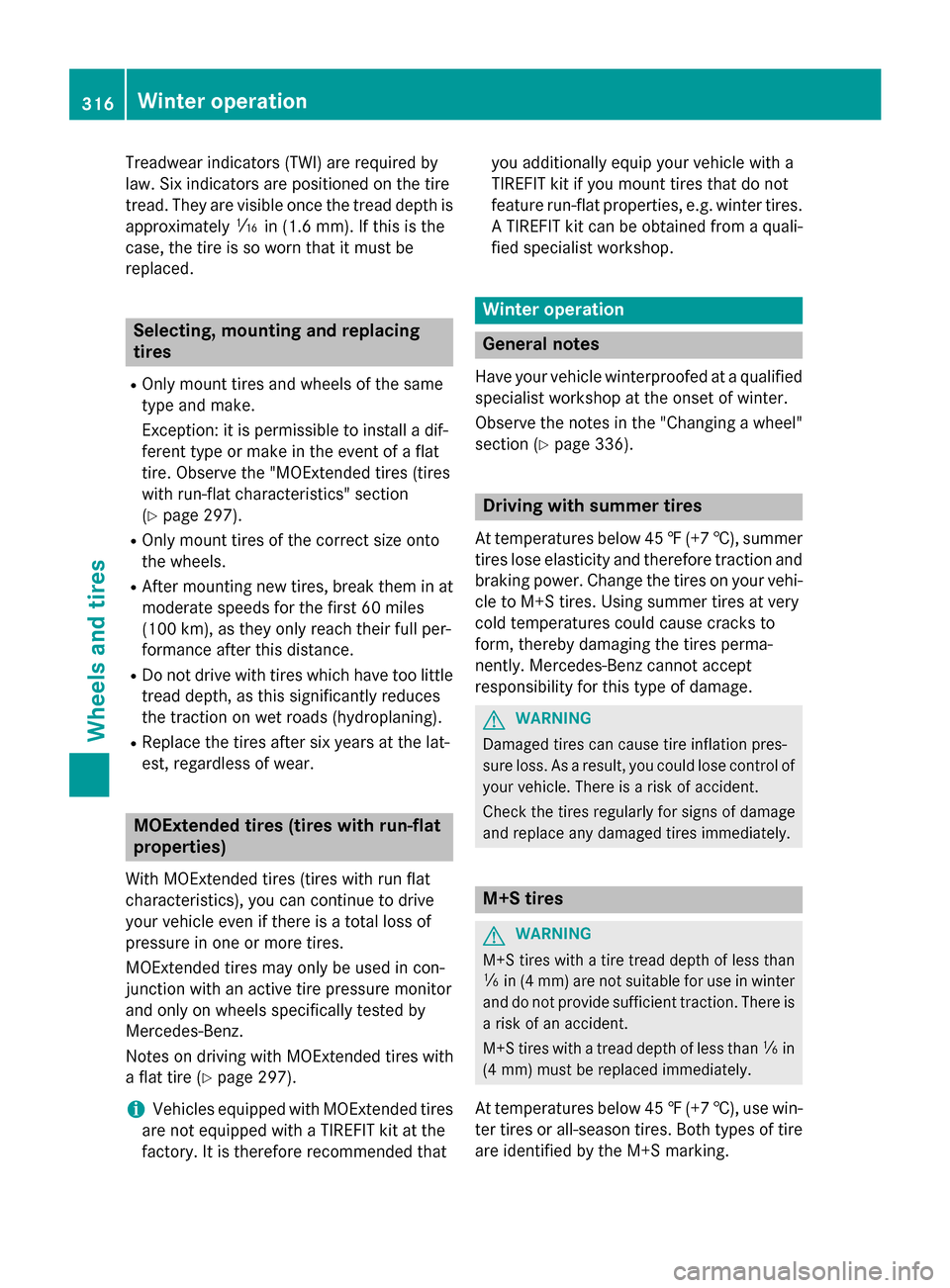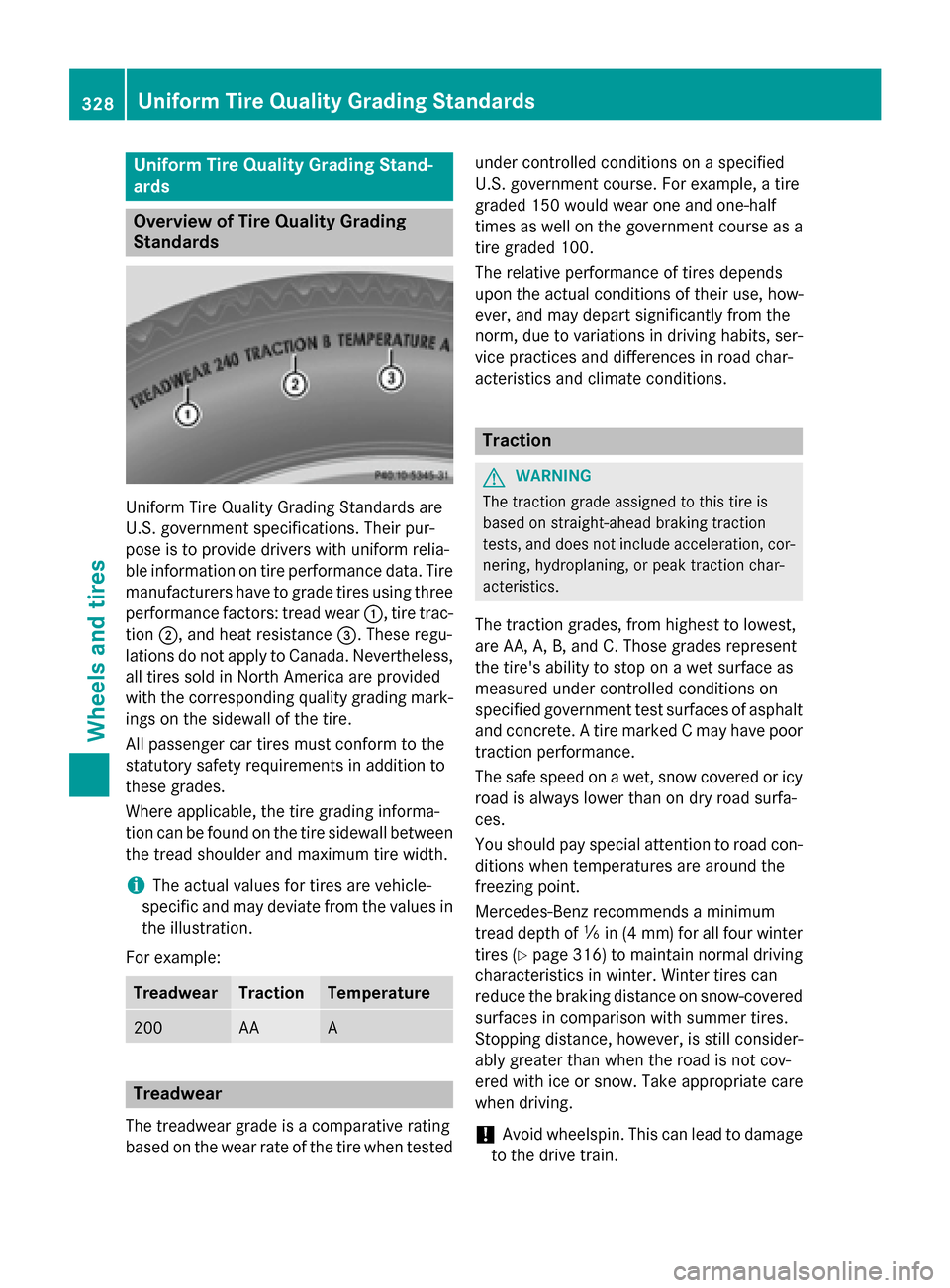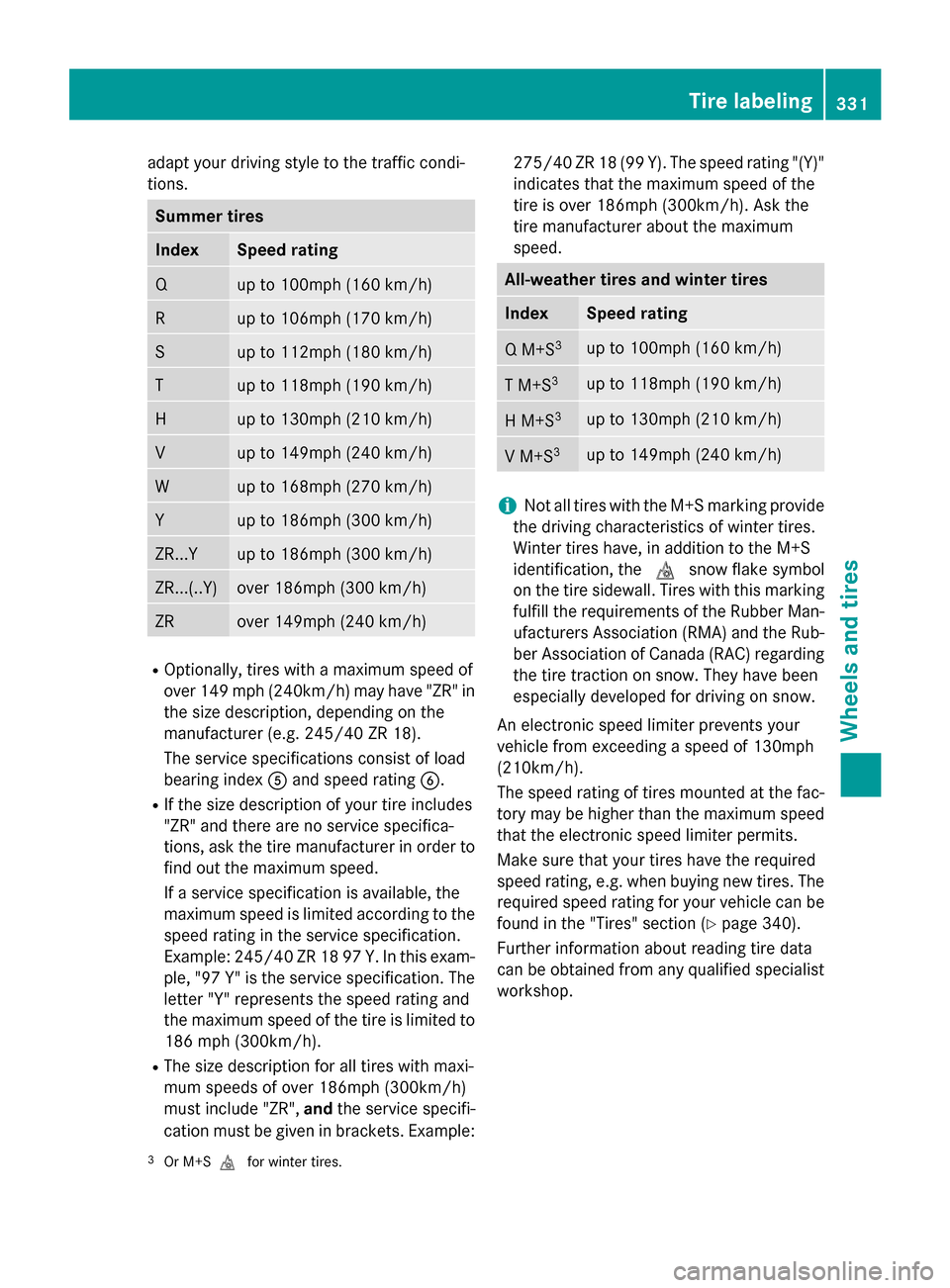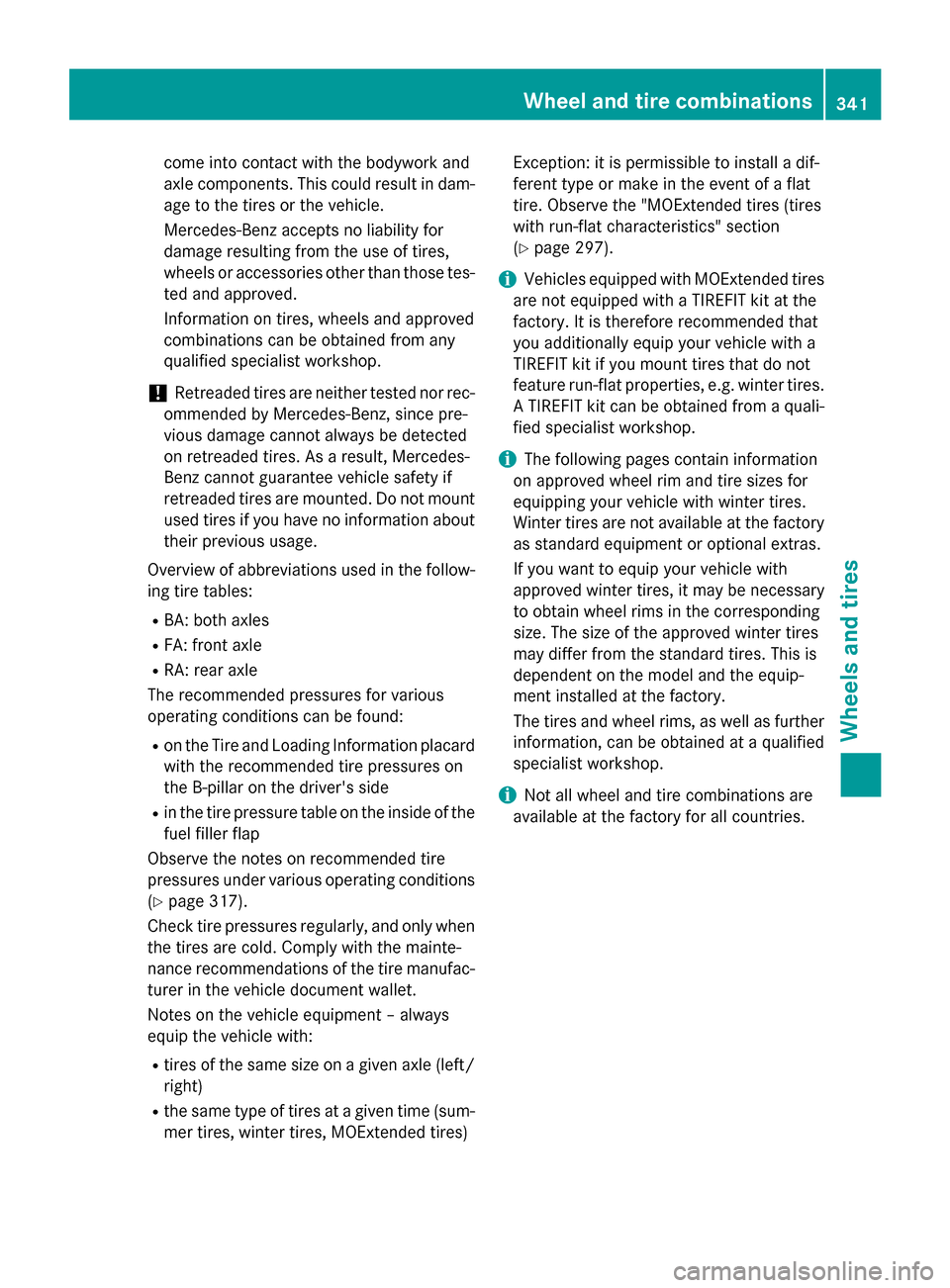2014 MERCEDES-BENZ CLA-Class winter tires
[x] Cancel search: winter tiresPage 318 of 358

Treadwear indicators (TWI) are required by
law. Six indicators are positioned on the tire
tread. They are visible once the tread depth is
approximately 00CDin (1.6 mm). If this is the
case, the tire is so worn that it must be
replaced. Selecting, mounting and replacing
tires
R Only mount tires and wheels of the same
type and make.
Exception: it is permissible to install a dif-
ferent type or make in the event of a flat
tire. Observe the "MOExtended tires (tires
with run-flat characteristics" section
(Y page 297).
R Only mount tires of the correct size onto
the wheels.
R After mounting new tires, break them in at
moderate speeds for the first 60 miles
(100 km), as they only reach their full per-
formance after this distance.
R Do not drive with tires which have too little
tread depth, as this significantly reduces
the traction on wet roads (hydroplaning).
R Replace the tires after six years at the lat-
est, regardless of wear. MOExtended tires (tires with run-flat
properties)
With MOExtended tires (tires with run flat
characteristics), you can continue to drive
your vehicle even if there is a total loss of
pressure in one or more tires.
MOExtended tires may only be used in con-
junction with an active tire pressure monitor
and only on wheels specifically tested by
Mercedes-Benz.
Notes on driving with MOExtended tires with
a flat tire (Y page 297).
i Vehicles equipped with MOExtended tires
are not equipped with a TIREFIT kit at the
factory. It is therefore recommended that you additionally equip your vehicle with a
TIREFIT kit if you mount tires that do not
feature run-flat properties, e.g. winter tires.
A TIREFIT kit can be obtained from a quali- fied specialist workshop. Winter operation
General notes
Have your vehicle winterproofed at a qualified specialist workshop at the onset of winter.
Observe the notes in the "Changing a wheel"
section (Y page 336). Driving with summer tires
At temperatures below 45 ‡(+7 †), summer
tires lose elasticity and therefore traction and braking power. Change the tires on your vehi-cle to M+S tires. Using summer tires at very
cold temperatures could cause cracks to
form, thereby damaging the tires perma-
nently. Mercedes-Benz cannot accept
responsibility for this type of damage. G
WARNING
Damaged tires can cause tire inflation pres-
sure loss. As a result, you could lose control of your vehicle. There is a risk of accident.
Check the tires regularly for signs of damage
and replace any damaged tires immediately. M+S tires
G
WARNING
M+S tires with a tire tread depth of less than
00CF in (4 mm) are not suitable for use in winter
and do not provide sufficient traction. There is
a risk of an accident.
M+S tires with a tread depth of less than 00CFin
(4 mm) must be replaced immediately.
At temperatures below 45 ‡(+7 †), use win-
ter tires or all-season tires. Both types of tire are identified by the M+S marking. 316
Winter operationWheels and tires
Page 319 of 358

Only winter tires bearing the
004Dsnowflake
symbol in addition to the M+S marking pro-
vide the best possible grip in wintry road con- ditions. Only these tires will allow driving
safety systems such as ABS and ESP ®
to
function optimally in winter. These tires have
been developed specifically for driving in
snow.
Use M+S tires of the same make and tread on
all wheels to maintain safe handling charac-
teristics.
Always observe the maximum permissible
speed specified for the M+S tires you have
mounted.
Once the winter tires are mounted:
X Check the tire pressures (Y page 320).
X Restart the tire pressure monitor
(Y page 323). Snow chains
G
WARNING
If snow chains are mounted on the rear
wheels, the snow chains could cause abrasion
to the vehicle body or to chassis components.
This could cause damage to the vehicle or the tires. There is a risk of an accident.
To avoid hazardous situations:
R never mount snow chains on the rear
wheels
R only mount snow chains in pairs on the
front wheels.
! On some tire sizes there is not enough
space for snow chains. To avoid damage to the vehicle or tires, observe the "Wheel and
tire combinations" section under "Tires and wheels".
! Vehicles with steel wheels:
if you
mount snow chains on steel wheels, you
may damage the hub caps. Remove the hub caps from the relevant wheels before
mounting the snow chains. For safety reasons, Mercedes-Benz recom-
mends that you only use snow chains that
have been specially approved for your vehicle by Mercedes-Benz, or are of a correspondingstandard of quality.
If you intend to mount snow chains, please
bear the following points in mind:
R Snow chains may not be mounted on all
wheel/tire combinations. Permissible
wheel-tire combinations (Y page 340).
R Only use snow chains when driving on
roads completely covered by snow.
Remove the snow chains as soon as possi- ble when you come to a road that is not
snow-covered.
R Local regulations may restrict the use of
snow chains. Observe the appropriate reg-
ulations if you wish to mount snow chains.
R Do not exceed the maximum permissible
speed of 30 mph (50 km/h).
R When snow chains are installed, never use
Active Parking Assist (Y page 181).
i You may wish to deactivate ESP ®
(Y page 68) when pulling away with snow
chains installed. You can thereby allow the
wheels to spin in a controlled manner, ach-
ieving an increased driving force (cutting
action). Tire pressure
Tire pressure specifications
G
WARNING
Underinflated or overinflated tires pose the
following risks:
R the tires may burst, especially as the load
and vehicle speed increase.
R the tires may wear excessively and/or
unevenly, which may greatly impair tire
traction.
R the driving characteristics, as well as steer-
ing and braking, may be greatly impaired.
There is a risk of an accident. Tire pressure
317Wheels and tires
Z
Page 330 of 358

Uniform Tire Quality Grading Stand-
ards Overview of Tire Quality Grading
Standards
Uniform Tire Quality Grading Standards are
U.S. government specifications. Their pur-
pose is to provide drivers with uniform relia-
ble information on tire performance data. Tire
manufacturers have to grade tires using three
performance factors: tread wear 0043, tire trac-
tion 0044, and heat resistance 0087. These regu-
lations do not apply to Canada. Nevertheless,
all tires sold in North America are provided
with the corresponding quality grading mark- ings on the sidewall of the tire.
All passenger car tires must conform to the
statutory safety requirements in addition to
these grades.
Where applicable, the tire grading informa-
tion can be found on the tire sidewall between
the tread shoulder and maximum tire width.
i The actual values for tires are vehicle-
specific and may deviate from the values in
the illustration.
For example: Treadwear Traction Temperature
200 AA A
Treadwear
The treadwear grade is a comparative rating
based on the wear rate of the tire when tested under controlled conditions on a specified
U.S. government course. For example, a tire
graded 150 would wear one and one-half
times as well on the government course as a tire graded 100.
The relative performance of tires depends
upon the actual conditions of their use, how-
ever, and may depart significantly from the
norm, due to variations in driving habits, ser-
vice practices and differences in road char-
acteristics and climate conditions. Traction
G
WARNING
The traction grade assigned to this tire is
based on straight-ahead braking traction
tests, and does not include acceleration, cor- nering, hydroplaning, or peak traction char-
acteristics.
The traction grades, from highest to lowest,
are AA, A, B, and C. Those grades represent
the tire's ability to stop on a wet surface as
measured under controlled conditions on
specified government test surfaces of asphalt
and concrete. A tire marked C may have poor
traction performance.
The safe speed on a wet, snow covered or icy road is always lower than on dry road surfa-
ces.
You should pay special attention to road con-
ditions when temperatures are around the
freezing point.
Mercedes-Benz recommends a minimum
tread depth of 00CFin (4 mm) for all four winter
tires (Y page 316) to maintain normal driving
characteristics in winter. Winter tires can
reduce the braking distance on snow-covered surfaces in comparison with summer tires.
Stopping distance, however, is still consider-
ably greater than when the road is not cov-
ered with ice or snow. Take appropriate care
when driving.
! Avoid wheelspin. This can lead to damage
to the drive train. 328
Uniform Tire Quality Grading StandardsWheels and tires
Page 333 of 358

adapt your driving style to the traffic condi-
tions. Summer tires
Index Speed rating
Q up to 100mph (160 km/h)
R up to 106mph (170 km/h)
S up to 112mph (180 km/h)
T up to 118mph (190 km/h)
H up to 130mph (210 km/h)
V up to 149mph (240 km/h)
W up to 168mph (270 km/h)
Y up to 186mph (300 km/h)
ZR...Y up to 186mph (300 km/h)
ZR...(..Y) over 186mph
(300 km/h) ZR over 149mph
(240 km/h) R
Option ally, tires with a maximum speed of
over 149 mph (240km/h) may have "ZR" in the size description, depending on the
manufacturer (e.g. 245/40 ZR 18).
The service specifications consist of load
bearing index 0083and speed rating 0084.
R If the size description of your tire includes
"ZR" and there are no service specifica-
tions, ask the tire manufacturer in order to
find out the maximum speed.
If a service specification is available, the
maximum speed is limited according to the
speed rating in the service specification.
Example: 245/40 ZR 18 97 Y. In this exam-
ple, "97 Y" is the service specification. The letter "Y" represents the speed rating and
the maximum speed of the tire is limited to
186 mph (300km/h).
R The size description for all tires with maxi-
mum speeds of over 186mph (300km/h)
must include "ZR", andthe service specifi-
cation must be given in brackets. Example: 275/40 ZR 18 (99 Y). The speed rating "(Y)"
indicates that the maximum speed of the
tire is over 186mph (300km/h). Ask the
tire manufacturer about the maximum
speed. All-weather tires and winter tires
Index Speed rating
Q M+S
3 up to 100mph (160 km/h)
T M+S
3 up to 118mph (190 km/h)
H M+S
3 up to 130mph (210 km/h)
V M+S
3 up to 149mph (240 km/h)
i
Not all tires with the M+S marking provide
the driving characteristics of winter tires.
Winter tires have, in addition to the M+S
identification, the 004Dsnow flake symbol
on the tire sidewall. Tires with this marking
fulfill the requirements of the Rubber Man- ufacturers Association (RMA) and the Rub-
ber Association of Canada (RAC) regarding
the tire traction on snow. They have been
especially developed for driving on snow.
An electronic speed limiter prevents your
vehicle from exceeding a speed of 130mph
(210km/h).
The speed rating of tires mounted at the fac- tory may be higher than the maximum speed
that the electronic speed limiter permits.
Make sure that your tires have the required
speed rating, e.g. when buying new tires. The
required speed rating for your vehicle can be
found in the "Tires" section (Y page 340).
Further information about reading tire data
can be obtained from any qualified specialist
workshop.
3 Or M+S 004Dfor winter tires. Tire labeling
331Wheels and tires Z
Page 343 of 358

come into contact with the bodywork and
axle components. This could result in dam- age to the tires or the vehicle.
Mercedes-Benz accepts no liability for
damage resulting from the use of tires,
wheels or accessories other than those tes-
ted and approved.
Information on tires, wheels and approved
combinations can be obtained from any
qualified specialist workshop.
! Retreaded tires are neither tested nor rec-
ommended by Mercedes-Benz, since pre-
vious damage cannot always be detected
on retreaded tires. As a result, Mercedes-
Benz cannot guarantee vehicle safety if
retreaded tires are mounted. Do not mount used tires if you have no information about
their previous usage.
Overview of abbreviations used in the follow-
ing tire tables:
R BA: both axles
R FA: front axle
R RA: rear axle
The recommended pressures for various
operating conditions can be found:
R on the Tire and Loading Information placard
with the recommended tire pressures on
the B-pillar on the driver's side
R in the tire pressure table on the inside of the
fuel filler flap
Observe the notes on recommended tire
pressures under various operating conditions (Y page 317).
Check tire pressures regularly, and only when the tires are cold. Comply with the mainte-
nance recommendations of the tire manufac-
turer in the vehicle document wallet.
Notes on the vehicle equipment – always
equip the vehicle with:
R tires of the same size on a given axle (left/
right)
R the same type of tires at a given time (sum-
mer tires, winter tires, MOExtended tires) Exception: it is permissible to install a dif-
ferent type or make in the event of a flat
tire. Observe the "MOExtended tires (tires
with run-flat characteristics" section
(Y
page 297).
i Vehicles equipped with MOExtended tires
are not equipped with a TIREFIT kit at the
factory. It is therefore recommended that
you additionally equip your vehicle with a
TIREFIT kit if you mount tires that do not
feature run-flat properties, e.g. winter tires. A TIREFIT kit can be obtained from a quali- fied specialist workshop.
i The following pages contain information
on approved wheel rim and tire sizes for
equipping your vehicle with winter tires.
Winter tires are not available at the factory as standard equipment or optional extras.
If you want to equip your vehicle with
approved winter tires, it may be necessary
to obtain wheel rims in the corresponding
size. The size of the approved winter tires
may differ from the standard tires. This is
dependent on the model and the equip-
ment installed at the factory.
The tires and wheel rims, as well as further
information, can be obtained at a qualified
specialist workshop.
i Not all wheel and tire combinations are
available at the factory for all countries. Wheel and tire combinations
341Wheels and tires Z
Page 344 of 358

Tires
CLA 250 Summer tires
R 17
Tires Wheels
BA: 225/4
5 R17 91 V 4 BA: 7.5 J x 17 H2
Wheel offset: 2.07 in (52.5 mm)
BA: 225/45 R17 91 W
4 BA: 7.5 J x 17 H2
Wheel offset: 2.07 in (52.5 mm)
R 18
Tires Wheels
BA: 225/40R18 92 W XL
4, 5, 6 BA: 7.5 J x 18 H2
Wheel offset: 2.05 in (52 mm)
All-weather tires
R 17 Tires Wheels
BA: 225/45 R17 91 H XL M+S
5, 4 BA: 7.5 J x 17 H2
Wheel offset: 2.07 in (52.5 mm)
Winter tires
R 17
Tires Wheels
BA: 205/50 R17 93 H XL M+S
004D5 BA: 6.5 J x 17 H2
Wheel offset: 1.93 in (49 mm)
4
Use of snow chains not permitted. Observe the notes in the section on snow chains.
5 Also available as MOExtended tires.
6 Observe the notes on "Large wheels" in the "Wheel/tire combination" section. 342
Wheel and tire combinationsWheels and tires
Page 345 of 358

CLA 250 4MATIC
Summer tires
R 17
Tires Wheels
BA: 225/45 R17 91 V
4 BA: 7.5 J x 17 H2
Wheel offset: 2.07 in (52.5 mm)
BA: 225/45 R17 91 W
4 BA: 7.5 J x 17 H2
Wheel offset: 2.07 in (52.5 mm)
R 18
Tires Wheels
BA: 225/40 R18 92 W XL
5, 4, 6 BA: 7.5 J x 18 H2
Wheel offset: 2.05 in (52 mm)
All-weather tires
R 17 Tires Wheels
BA: 225/45 R17 91 H XL M+S
5, 4 BA: 7.5 J x 17 H2
Wheel offset: 2.07 in (52.5 mm)
Winter tires
R 17
Tires Wheels
BA: 205/50 R17 93 H XL M+S
004D5 BA: 6.5 J x 17 H2
Wheel offset: 1.93 in (49 mm)
CLA 45 AMG 4MATIC
Summer tires
R 18
Tires Wheels
BA: 235/40 ZR18 95 Y XL
4 BA: 8.0 J x 18 H2
Wheel offset: 1.89 in (48 mm)
4
Use of snow chains not permitted. Observe the notes in the section on snow chains.
5 Also available as MOExtended tires.
6 Observe the notes on "Large wheels" in the "Wheel/tire combination" section. Wheel and tire combinations
343Wheels and tires Z
Page 346 of 358

R 19
Tires Wheels
BA: 235/35 ZR19 91 Y XL
4 BA: 8.0 J x 19 H2
Wheel offset: 1.89 in (48 mm)
Winter tires
R 18
Tires Wheels
BA: 215/45 R18 93 V XL M+S004D BA: 7.5 J x 18 H2
Wheel offset: 1.67 in (42.5 mm)
BA: 235/40 R18 95 V XL M+S
004D4 BA: 8.0 J x 18 H2
Wheel offset: 1.89 in (48 mm)
4
Use of snow chains not permitted. Observe the notes in the section on snow chains. 344
Wheel and tire combinationsWheels and tires